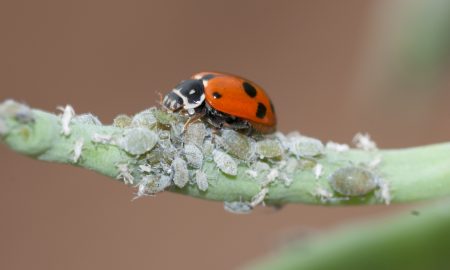The appearance of moderate numbers of native budworm grubs in pulse crops after insecticide treatment have been of concern.
Where have they been reported?
In many areas across the Victorian Mallee (Swan Hill / Hopetoun / Sea Lake), pulses, particularly field pea and lentil crops, were sprayed for native budworm (Helicoverpa punctigera) caterpillars in the first or second week of October.
Alpha-cypermethrin was the most common active ingredient applied.
On revisiting sprayed crops (up to 10 days post-spray), many were found to have had surprising densities of young grubs, leading to concerns about control failures.
The caterpillars varied in size, but on average were 10 mm.
Subsequent samples sent to us confirmed that the species was H. punctigera.
A similar experience has occurred in the South Australian Eyre Peninsula, where larvae have survived in many sprayed crops. Again, larvae were mostly H. punctigera, although some Helicoverpa armigera (cotton bollworm) were also present.
Our advice
There are several possible explanations for the appearance of grubs in crops some days after a spray:
1. Young grubs avoiding sprays
Unusually hot weather can drive very young larvae (1-3 mm) to bore directly into pods, when they would otherwise normally graze on the leaf and pod surfaces. Some days after (when temperatures have declined), the grubs re-emerge and start to surface feed again beyond the reach of the insecticide’s residual activity. In the Mallee, many of the early days of October (3rd -6th, 9th and 10th Oct) had temperatures above 33°C, some well above 36°C.
2. Eggs are not susceptible to most insecticides
Many larvae hatching from a late September egg lay will have missed the spray, and may have emerged after the end of the chemical’s residual activity.
3. Insecticide resistance
There is no substantial evidence that native budworm has yet acquired resistance to insecticides, at least in part due to its extensive migratory behaviour from breeding sites in the arid inland where the species is not exposed to chemical pesticides.
In contrast, the sibling species, Helicoverpa armigera, is well known to be resistant to some insecticides, and this species can occasionally occur in spring in our cropping regions. The larvae can be difficult to distinguish from native budworm.
4. Poor coverage during aerial sprays
This is always a possibility particularly in heavy crops, but is unlikely in this year’s very light crops.
Of these possibilities, we believe the first two are the most plausible explanations for the appearance of grubs after a spray this season.
The lesson from this is to avoid spraying immediately after a spike in particularly hot temperatures.
Nonetheless, resistance can never be ruled out and we ask that all growers remain vigilant to the possibility, and report possible failures to us.
Acknowledgements
Source of field reports
Matthew Bissett – Consultant, AGRIvision Consultants (Victorian Mallee)
Dylan Fox – Agronomist, AGRIvision Consultants (Victorian Mallee)
Bill Kimber – Entomologist, South Australian Research and Development Institute (SARDI)
Luke Maher – Consultant, AGRIvision Consultants (Victorian Mallee)
Cover image: Photo by Western Australian Agriculture Authority, 2015





